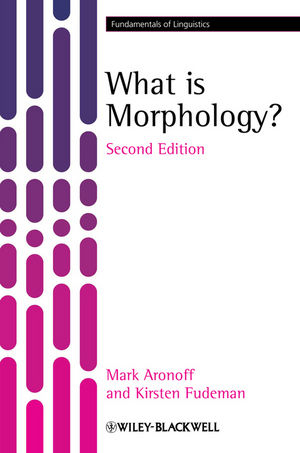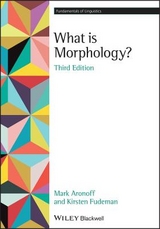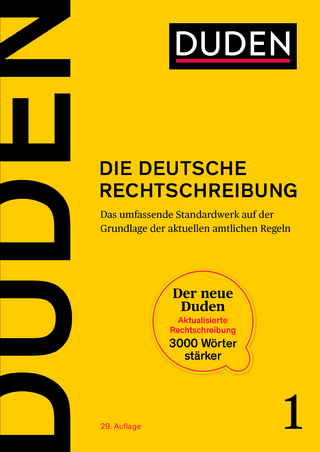
What is Morphology? 2e
Wiley-Blackwell (an imprint of John Wiley & Sons Ltd) (Verlag)
978-1-4051-9467-9 (ISBN)
- Titel erscheint in neuer Auflage
- Artikel merken
Mark Aronoff is Professor of Linguistics at Stony Brook University (SUNY). He is co-editor, with Janie Rees-Miller, of The Handbook of Linguistics (Wiley-Blackwell, 2001), and served as editor of the journal Language from 1995 to 2000. Kirsten Fudeman is Professor of French at the University of Pittsburgh. She is the author of Vernacular Voices: Language and Identity in Medieval French Jewish Communities (2010).
Preface viii Acknowledgments xiv Abbreviations xv Remarks on Transcription xviii The International Phonetic Alphabet xx 1 Thinking about Morphology and Morphological Analysis 1 1.1 What is Morphology? 1 1.2 Morphemes 2 1.3 Morphology in Action 4 1.4 Background and Beliefs 10 1.5 Introduction to Morphological Analysis 12 1.6 Summary 22 Introduction to Kujamaat Joola 23 Further Reading 26 Exercises 27 2 Words and Lexemes 33 2.1 What is a Word? 34 2.2 Empirical Tests for Wordhood 38 2.3 Types of Words 40 2.4 Inflection vs. Derivation 47 2.5 Two Approaches to Morphology: Item-and-Arrangement, Item-and-Process 49 2.6 The Lexicon 54 2.7 Summary 57 Kujamaat Joola Noun Classes 58 Further Reading 67 Exercises 68 3 Morphology and Phonology 73 3.1 Allomorphs 74 3.2 Prosodic Morphology 78 3.3 Primary and Secondary Affixes 82 3.4 Linguistic Exaptation, Leveling, and Analogy 86 3.5 Morphophonology and Secret Languages 93 3.6 Summary 95 Kujamaat Joola Morphophonology 96 Further Reading 103 Exercises 104 4 Derivation and the Lexicon 109 4.1 The Saussurean Sign 109 4.2 Motivation and Compositionality 110 4.3 Derivation and Structure 123 4.4 Summary 130 Derivation in Kujamaat Joola 131 Further Reading 132 Exercises 133 5 Derivation and Semantics 136 5.1 The Polysemy Problem 137 5.2 The Semantics of Derived Lexemes 139 5.3 Summary 147 Derivation and Verbs in Kujamaat Joola 148 Further Reading 151 Exercises 152 6 Inflection 157 6.1 What is Inflection? 159 6.2 Inflection vs. Derivation 168 6.3 Inventory of Inflectional Morphology Types 171 6.4 Syncretism 177 6.5 Typology 178 6.6 Summary 180 Agreement in Kujamaat Joola 182 Further Reading 187 Exercises 189 7 Morphology and Syntax 196 7.1 Morphological vs. Syntactic Inflection 197 7.2 Structural Constraints on Morphological Inflection 198 7.3 Inflection and Universal Grammar 201 7.4 Grammatical Function Change 203 7.5 Summary 209 Kujamaat Joola Verb Morphology 212 A Brief Survey of Kujamaat Joola Syntax 219 Further Reading 222 Exercises 223 8 Morphological Productivity and the Mental Lexicon 226 8.1 What is Morphological Productivity? 227 8.2 Productivity and Structure: Negative Prefixes in English 230 8.3 Degrees of Productivity 231 8.4 Salience and Productivity 236 8.5 Testing Productivity 238 8.6 The Mental Lexicon, Psycholinguistics, and Neurolinguistics 246 8.7 Conclusion 252 Further Reading 253 Exercises 254 Glossary 258 References 273 Index 280
| Erscheint lt. Verlag | 5.11.2010 |
|---|---|
| Reihe/Serie | Fundamentals of Linguistics |
| Verlagsort | Chicester |
| Sprache | englisch |
| Maße | 152 x 229 mm |
| Gewicht | 444 g |
| Themenwelt | Schulbuch / Wörterbuch ► Wörterbuch / Fremdsprachen |
| Geisteswissenschaften ► Sprach- / Literaturwissenschaft ► Sprachwissenschaft | |
| ISBN-10 | 1-4051-9467-7 / 1405194677 |
| ISBN-13 | 978-1-4051-9467-9 / 9781405194679 |
| Zustand | Neuware |
| Informationen gemäß Produktsicherheitsverordnung (GPSR) | |
| Haben Sie eine Frage zum Produkt? |
aus dem Bereich



